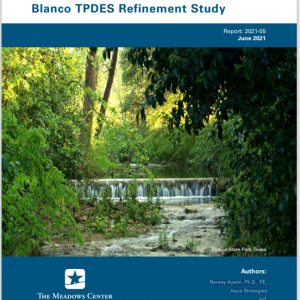Blanco TPDES Refinement Study

The Blanco Water Reclamation Task Force commissioned the Blanco TPDES Refinement Study report by Aqua Strategies, KIT, and Blue Creek Consulting as a way to investigate alternatives to direct discharge of wastewater into the Blanco River. Their report was published through the Meadows Center for Water and the Environment.
Executive Summary:
A simple water balance model was developed based on numbers provided by the City of Blanco that showed that the most cost-effective short-term strategy to reduce the likelihood of having to discharge reclaimed water to the river is to increase the storage capacity of the ponds AND increase the area of irrigated land. The trade-off between area of irrigation and storage in order to avoid future discharge to the river is shown in later sections of this report. The spreadsheet uses daily weather data to show how discharge could be completely avoided in 40 years of historical weather under existing effluent production rates.
Executing agreements with adjacent landowners for use of the reclaimed water would result in relatively little cost, especially if the landowners would cover some or all of the cost of extending the distribution lines to their property. It is expected that at least 100 acres of additional land could be made available in the near future. The City has already executed an agreement with an adjacent landowner to irrigate 48 acres of land and is negotiating agreements with other landowners.
Doubling the capacity of the storage ponds (an additional 9.2 MG, or 28 ac-ft) would cost approximately $500,000. It is likely that the City will be able maintain Type 1 standards in its new pond, which is required in order to secure a permit to reuse the water under Chapter 210 of the Texas Water Code, but that has not yet been confirmed. Doubling the capacity of the holding ponds and increasing the area of land available for irrigation would ensure that the City does not have to discharge to the Blanco River under current effluent production rates, but both storage and irrigation area would need to be expanded to handle expected growth in effluent production in the future.
The City owns land adjacent to the wastewater treatment plant that would likely be suitable for construction of a new pond. Combined, the increased irrigated land and additional storage described above would reduce the probability of having to discharge to less than once every 40 years (equivalent to a less than 2.5 percent chance on an annual basis). This configuration would require the City to expand the acreage for TLAP in its permit, with TCEQ approval, and discontinue the discharge provision. The second figure in the Executive Summary shows the WWTP facility site and adjacent lands, including location of potential new storage pond. It should be noted that the City has identified a piece of land south of their current irrigation fields that should also be investigated for feasibility.
Even though the expansion of the ponds and area under irrigation would allow the City to handle all of its wastewater through a TLAP permit, the City is committed to continuing to find ways to reduce the nutrient load, thereby expanding the possibilities for reuse, and sale, of that reclaimed water. The new WWTP already has the ability to pump a coagulant into the secondary clarifier and this past week has initiated a study to try to optimize the dosing of alum (aluminum sulphate), to reduce the Total Phosphorus down from the current levels of approximately 1 mg/l. An October 2020 report by Dr. Ryan King after the 2019 algal bloom in the Blanco River indicated that major algal blooms can occur in the river when Total Phosphorus levels are as low as 15 µg/l (0.015 mg/l).
Biological Nutrient Removal (BNR) is another method commonly used to reduce nutrients in wastewater treatment plant facilities. A new system integrated into an aeration unit would cost somewhere between $150,000 and $200,000. Annual operating costs of the BNR facility would be low, mainly electricity. An advantage of the BNR system is that it reduces the need for the coagulant and therefore some savings are returned to the operator of the facility when both systems are in place. Very high-level calculations indicate that both systems (optimized use of coagulant and BNR facility) could lower Total Phosphorus down to 0.1 mg/l (and possibly much lower) at an operating cost of approximately $10,000 per year. Running a water line from the WWTP up to highway 281, in order to sell Chapter 210, Type 1 reclaimed water to future industrial customers would be fairly expensive if storage tanks were built at each end. The pipeline itself would cost around $1 million, with pump station and chlorine injection facilities expected to cost a similar amount. The total costs of the facilities would be around $5 million, with considerable annual O&M costs as well. The idea might be feasible, from a cost perspective, if there were enough customers for the water and if the cost of building the pipeline could be shared with others. Costs would be further reduced if the proposed new storage pond could be used, rather than a tank. This remains a long-term goal of the City and could be funded and constructed in phases.